Seven Big Island farms participated this year in the grant-funded Nutrition Grown Farmers’ Educational Program and Farm Trials. The program included Dr. Bogs’ online Perfect Soil course, Zoom meetings, Dr. Bogs’ book–Beyond Organic: Growing for Maximum Nutrition and Flavor, and side-by-side growing plots farm trials. The trials included comprehensive pre- and post-trial Nutrition Grown soil analyses (including microbiology), organically-approved soil amendments, help with the application of those, and plant tissue analyses. In every case, the fertilization of the control plot was left to the farmer’s discretion—for them to apply what they thought best.
The farms ranged in size from 5 to 25.5 acres, with the average being 12.5 acres. The median size of a farm in Hawaii is 5 acres (2017 Census of Agriculture). Most of the farmers were relatively new with farming their land. This shows the potential for a significant increase in crop production for our communities.
The farmers are Holly Young of Papa`aloa, Amanda Taeoalii of Pepe`ekeo, Yukie and Tim Ohashi of Hilo, Matt Drayer of Wood Valley, Jasmine Leitzel and Justin Canelas of Naalehu, Chelsea and Lori Cox of Naalehu, and Wendy and Andrew Graves of South Kona District. For the trial, all farmers grew Little Gem lettuce, which is a small, delicious lettuce. (Maximum 6-8 inch leaves are normal size for Little Gem lettuce.) The seeds used were all from the same batch, purchased from Johnny’s Seeds. Most farmers grew additional crops as part of the trials. All farmers successfully completed the course and they all were very happy to have been able to participate.
The soil analyses revealed numerous imbalances which were addressed with custom-made fertilizer mixes for each farmer. Post-trial soil analyses were compared to pre-trial soil analyses with an average of 12 of 22 measured soil parameters significantly improving. All farmers reported better yields, and quality in their Nutrition Grown beds as compared to their control beds. Plant tissue analyses revealed an overall 14% increase in minerals and protein in the Nutrition Grown lettuce versus the control lettuce.

These lettuce plants were grown in adjacent beds in exactly the same way except the Nutrition Grown lettuce on the right had soil that was amended according to the Beyond Organic Growing System (BOGS)
One thing that greatly impacted the farm trials was that Dr. Bogs had an accident in late November which required hip replacement surgery. This greatly delayed the initial soil analyses and subsequent amending of the soils. It is best to give the soil a month or more to integrate the amendments before planting. Due to the late amending, most growers started their seeds in trays and later transplanted. This means that the plants were affected by the potting soil and had less contact time with the Nutrition Grown soil than if they had been direct-seeded. Farther down in this report, this issue is readdressed.
HOLLY YOUNG of Grateful Farm in Papa`aloa—
Grateful Farm is a 17-acre farm, with 8 acres currently used for growing Okinawan sweet potatoes conventionally only every other year due to the poor soil quality. Papa`aloa mauka was used for sugarcane for over 100 years and is a very rainy area, which means that a lot of the minerals in the soil have been leached out.
The initial soil report showed a very low exchange capacity, which means the soil cannot hold very much nutrition. It had very low levels of phosphorus, calcium, magnesium, potassium, boron, manganese, copper, zinc, cobalt, molybdenum, and selenium. By contrast, the sulfur was excessively high, as was the sodium. Having imbalances like this are serious, but can be remedied.
Holly prepped the trial plots by double digging before the soil was sampled. She put sheep straw compost on both beds.
The Nutrition Grown plot had a full array of the needed nutrients and microbes applied according to the soil analyses. The control bed only had horse manure applied. It is recommended to wait at least 3 weeks before direct seeding into an amended plot to allow the nutrients to be more evenly distributed in the soil. Holly planted 16 days after amending. This shortened window may have affected the germination of the seeds and the growth of the plants.
Soil Analyses Reports NOTE: When discussing soil mineral levels and other soil parameters, we are using the term “high” to mean too high; “OK” levels are the desirable levels.
Holly Young’s Soil Analyses–

Microbiological Soil Analyses—Holly Young, Grateful Farm, Papa`aloa–
Beneficial microbiology in the soil is important to hold nutrients in the soil and make them available to the plants. Microbiological soil analyses are done with a 400x microscope.
Pre-trial report compared to post-trial report: The soil microbiology greatly struggles at Holly’s farm, which is attributed to the many years of chemical applications of various types. Each farmer in the program was supplied with a broad-spectrum microbial inoculant, and while most farmers in the program had excellent results with building beneficial bacteria in the soil, Holly’s was an exception. (See table of microbiology of all participants later in this report.) Pre-trial bacterial level was 15/slide field on the initial check, and 0/slide field on the recheck. These are extremely low numbers, as we would like to see about 2000 per slide field. Post-trial bacterial level was not improved with only 12/slide field on the initial check, and 0/slide field on the recheck. Other soil microbiology parameters—beneficial fungi, protozoa, and nematodes–did not show up on the pre-trial. Only one protozoan showed up in the post-trial soil. Protozoa are wanted in small numbers as they eat bacteria, recycling nutrients into the soil. In Holly’s case, they probably ate whatever additional bacteria were produced in the Nutrition Grown soil. No beneficial fungi or nematodes showed up in the post-trial.
Plant tissue data from Holly Young, Grateful Farm, Papa`aloa–
The Nutrition Grown plot contained numerous Little Gem lettuce plants and lilies, whereas the control plot was not supporting the plants even though seeded the same way. Due to the poor growth in the control bed, Holly was concerned that there would not be enough to actually take a sample. Indeed, the control plants performed so poorly that there was not enough plant tissue to do an accurate assessment of them. Only two plants survived, and they were only about 2 inches tall.
The Nutrition Grown lettuce was many times larger than the control, with leaves up to 8” tall. This lettuce was direct-seeded, so it had more time in contact with real soil than most in the overall trial which were started in potting soil in trays. See the comparison table later in this report illustrating brix measurements related to length of time in contact with soil. There may have been even better results had the Nutrition Grown plot been given at least 3 weeks between amending and planting. It takes time for the soil to “digest” nutrients. One concern that Holly had was that the plants were different sizes even though planted at the same time. This may have been due to her soil being “chunky” instead of “fine garden soil” that is recommended for lettuce. The chunks encourage the seeds to end up at different depths in the soil.
Holly also felt that there was poor germination. Excessive seed depth at planting could have caused this. Indeed, the post-trial soil sample developed a bunch of what appeared to be lettuce sprouts, which were probably from seeds which had been buried too deeply, and now had a chance to sprout.

Holly standing in her control bed (where almost nothing grew) with Nutrition Grown lettuce (on right)—many times larger than the 2-inch control (on left)
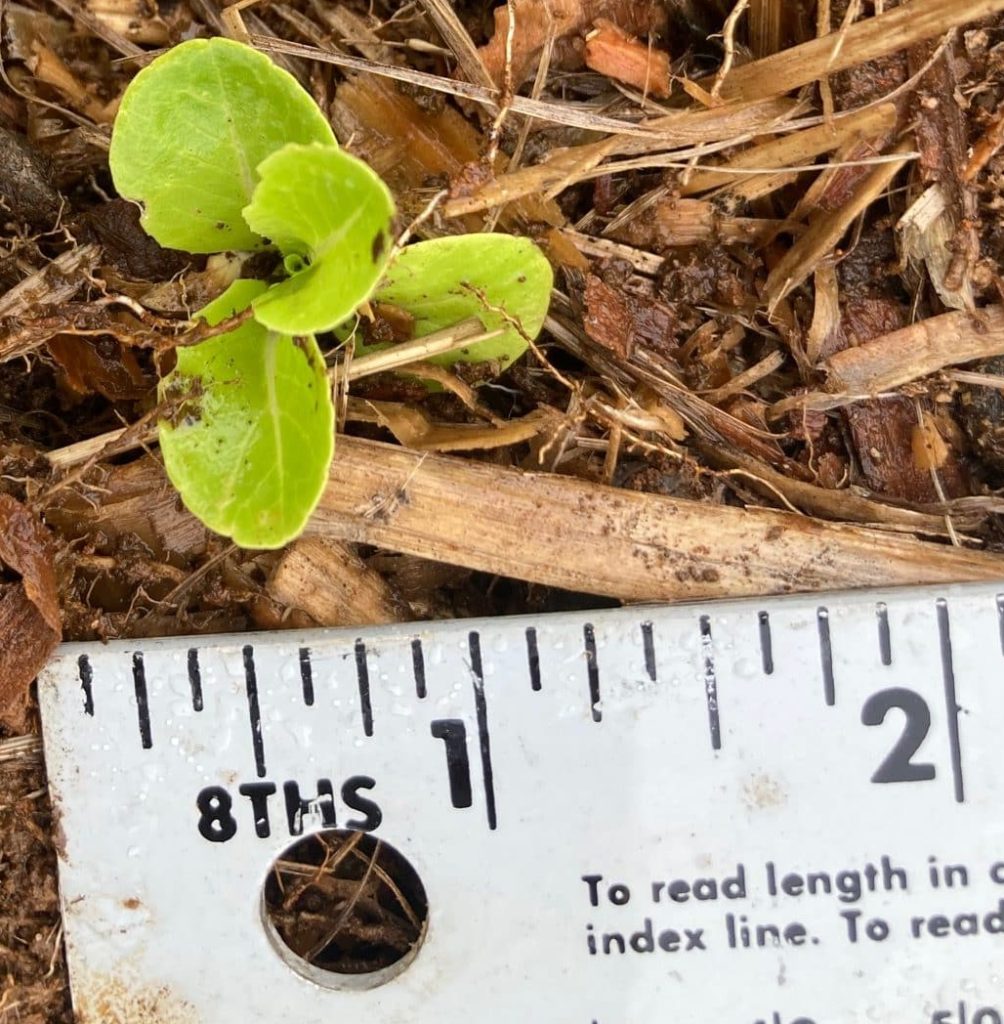
Holly’s Control Little Gem Lettuce
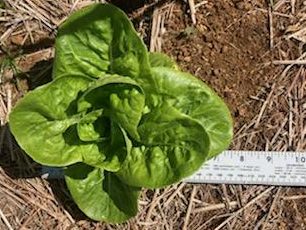
Holly’s Nutrition Grown Little Gem Lettuce
Course and Farm Trial Evaluation comments by Holly:
Evaluation: “What changes happened in your Nutrition Grown (amended according to the soil analyses) soil/plants versus the control?”
Holly: “There was a radical difference in the rate and amount of germination, size and color of the lettuce plants.”
AMANDA TAEOALII’S HOANAULU FARM IN PEPE`EKEO (NORTH OF HILO)
Hoanaulu Farm is a fairly new farm consisting of 15 acres in mixed use, including vegetables, ulu, and livestock. It is located mauka of the highway on old sugarcane land where they get a lot of rain. Amanda sells farm-to-car, with plans for a neighborhood pop-up market and selling to the ulu co-op.
Amanda’s Soil Analyses–


Amanda in her garden near her Nutrition Grown plants
Soil Reports: The initial soil report showed a very low exchange capacity, which means the soil cannot hold very much nutrition. We added a lot of dry humates to increase the exchange capacity. A lot of minerals, including the trace minerals, were very low. These are needed for the plants as well as for the beneficial microbes. The soil had very low levels of phosphorus, calcium, boron, manganese, zinc, cobalt, and molybdenum. By contrast, the magnesium, potassium, sodium, iron, and sulfur were excessively high, as was the aluminum. Having imbalances like this can be problematic.
The Nutrition Grown plot had a custom-made array of nutrients and microbes applied according to the soil analyses. The control bed had oyster shell, blood meal and chicken manure applied. Both plots had foliar sprays of fish emulsion, kelp, Dipel (BT), and a surfactant.
Amanda’s Microbiological Soil Analyses: (Post-trial comparison to the pre-trial report) The soil microbiology is much improved. Pre-trial bacterial level was 400/slide field on the initial check, and 15/slide field on the recheck. These are low/very low numbers. Post-trial bacterial level was much improved with increases to 700/slide field on the initial check, and 400/slide field on the recheck. These represent a 75% increase and a 2567% increase, respectively. Long strands of fungi were present in the post-trial check, but not in the pre-trial check.
Crop data and notes by Amanda
As soon as the Little Gem lettuce transplants were in the beds, the Nutrition Grown began outpacing the control in size. This continued until harvest, at which time the Nutrition Grown lettuces were approximately 57% larger. The Nutrition Grown also had a consistent bright, rich green color with a shiny sheen, whereas the color of the control was inconsistent. The flavor of the control was sweet to start, but bitter at the end, whereas the Nutrition Grown tasted sweet throughout.
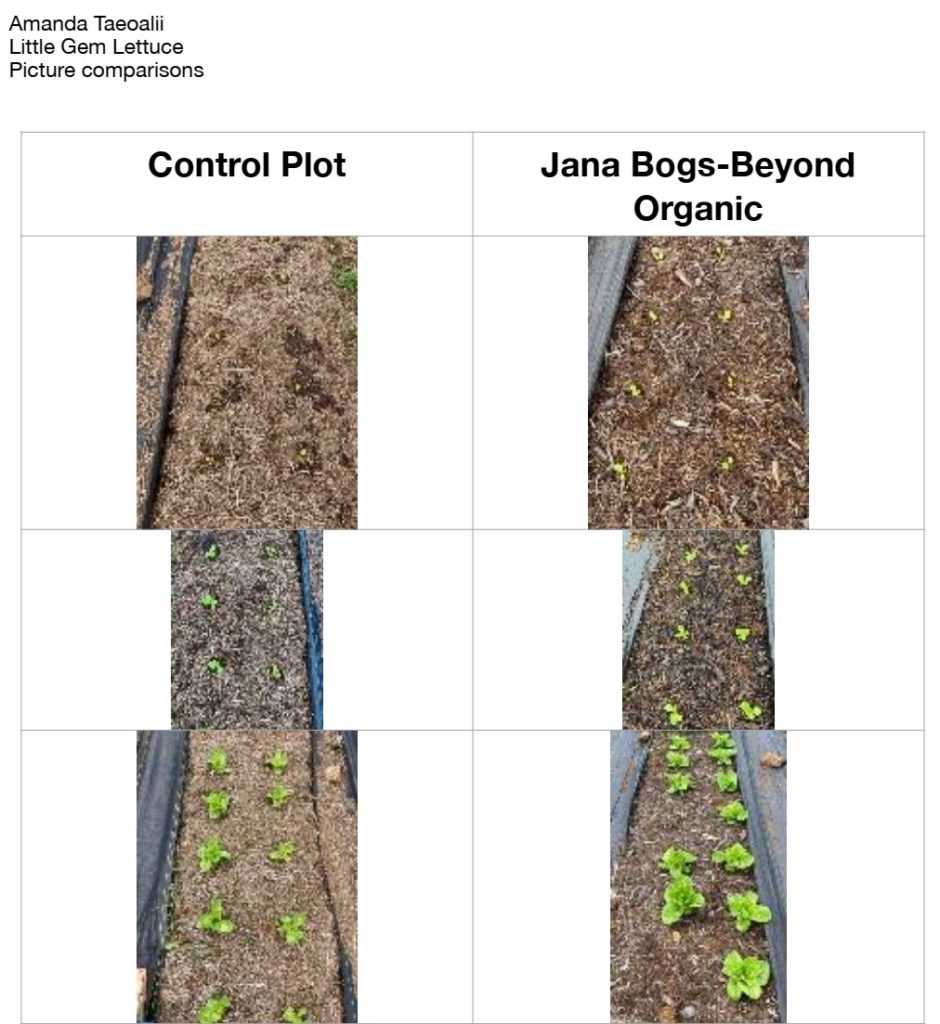
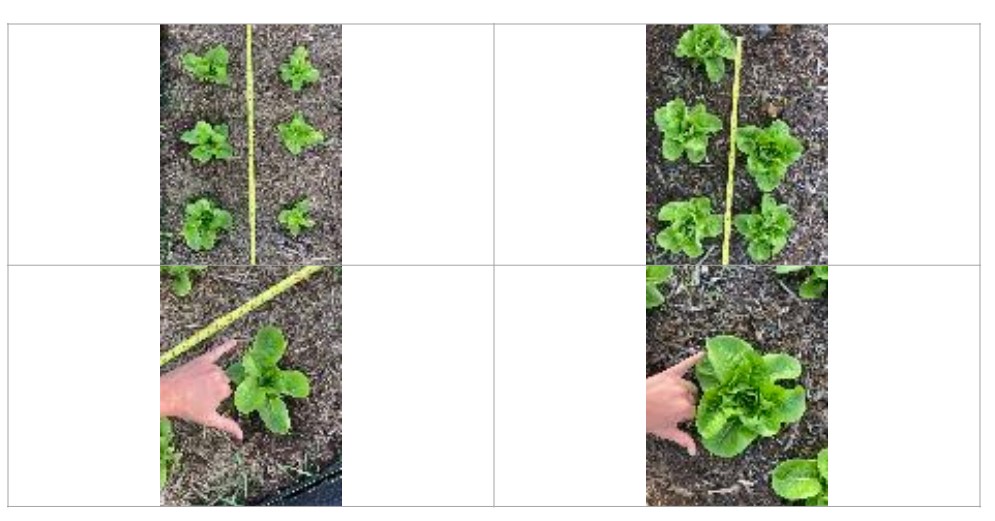
Course and Farm Trial Evaluation comments by Amanda:
When Amanda was asked…
“Do you like the e-book?” LOVE it, Its great information of WHY we need certain minerals and how they balance each other out. Its straight forward and simply explained. I will refer to it a lot.
“Were the mineral soil analyses helpful?” Yes. Especially after having read/watched the videos. The soil analysis makes it all come together. You also really understand what your starting point is.
“Were the microbiological soil analyses helpful?” YES. Also a huge part that I was missing in our past growing. A component that’s so important but I did not know.
“Was the plant tissue analysis helpful?” Its great proof in your methods and motivation to grow BEYOND ORGANICALLY
“What changes happened in your Nutrition Grown (amended according to the soil analyses) soil/plants versus the control?”
In my Nutrition Grown plot, I noticed bigger, healthier, and sweeter plants. There was less pest and disease. I also noticed a lot of mycelium growth in the Nutrition Grown plot. There were still plenty weeds, but they came out easier and did not grow back as fast.
In my control plot, plants grew slower, were not as brightly colored and more pest/disease damage. Lettuce was slightly bitter.
Jana and her Beyond Organic (Nutrition Grown) methods and program are incredible. I am so grateful I was able to participate. She guides you in the exact direction you need to go in order to grow healthy, nutritious food and fruit. She is easy to communicate with and is very passionate about gardening and farming. I would 100% recommend and encourage anyone wanting to grow large or small scale to use her methods and expertise.
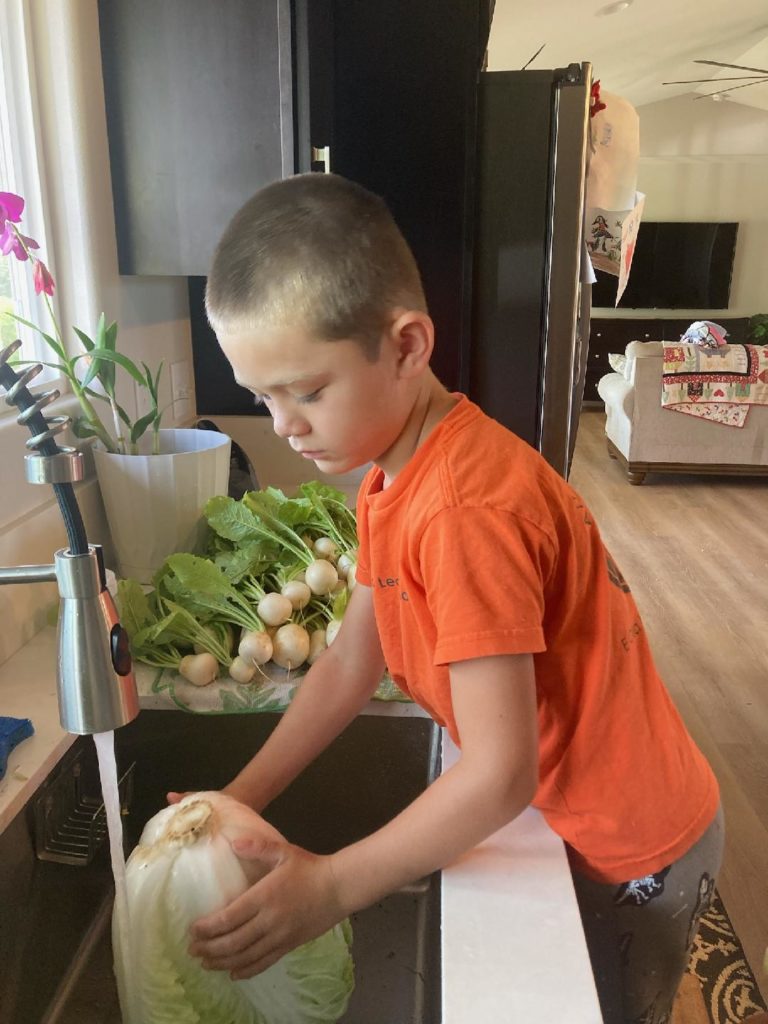
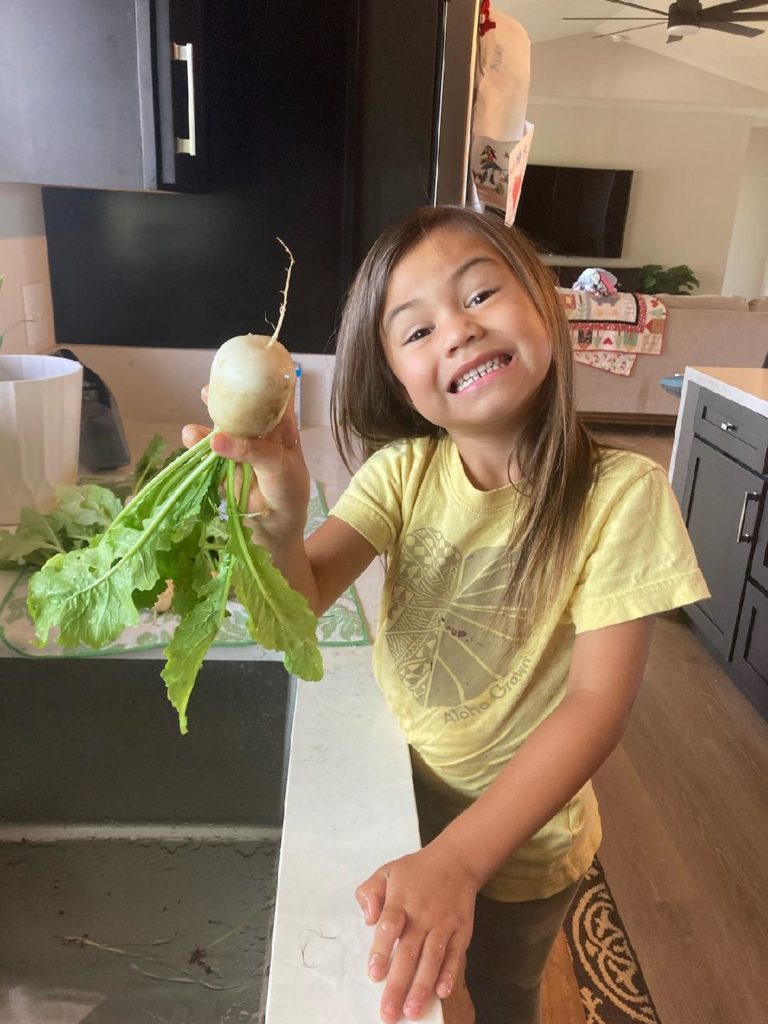
Amanda’s children are happy to help in the garden and with the produce
THE FARM OF YUKIE AND TIM OHASHI OF KAUMANA AREA OF HILO
Since 2017, Tim and Yukie Ohashi have had 8.9 acres near Kaumana Caves in Hilo which they have been developing into a vegetable/fruit farm and home place. It was used for sugarcane and ginger production in the past. They are growing a variety of crops to be sold through aggregator food hubs and via subscription CSA boxes.
They did a wonderful job preparing the soil. Here is Tim applying soil amendments with a drop spreader:
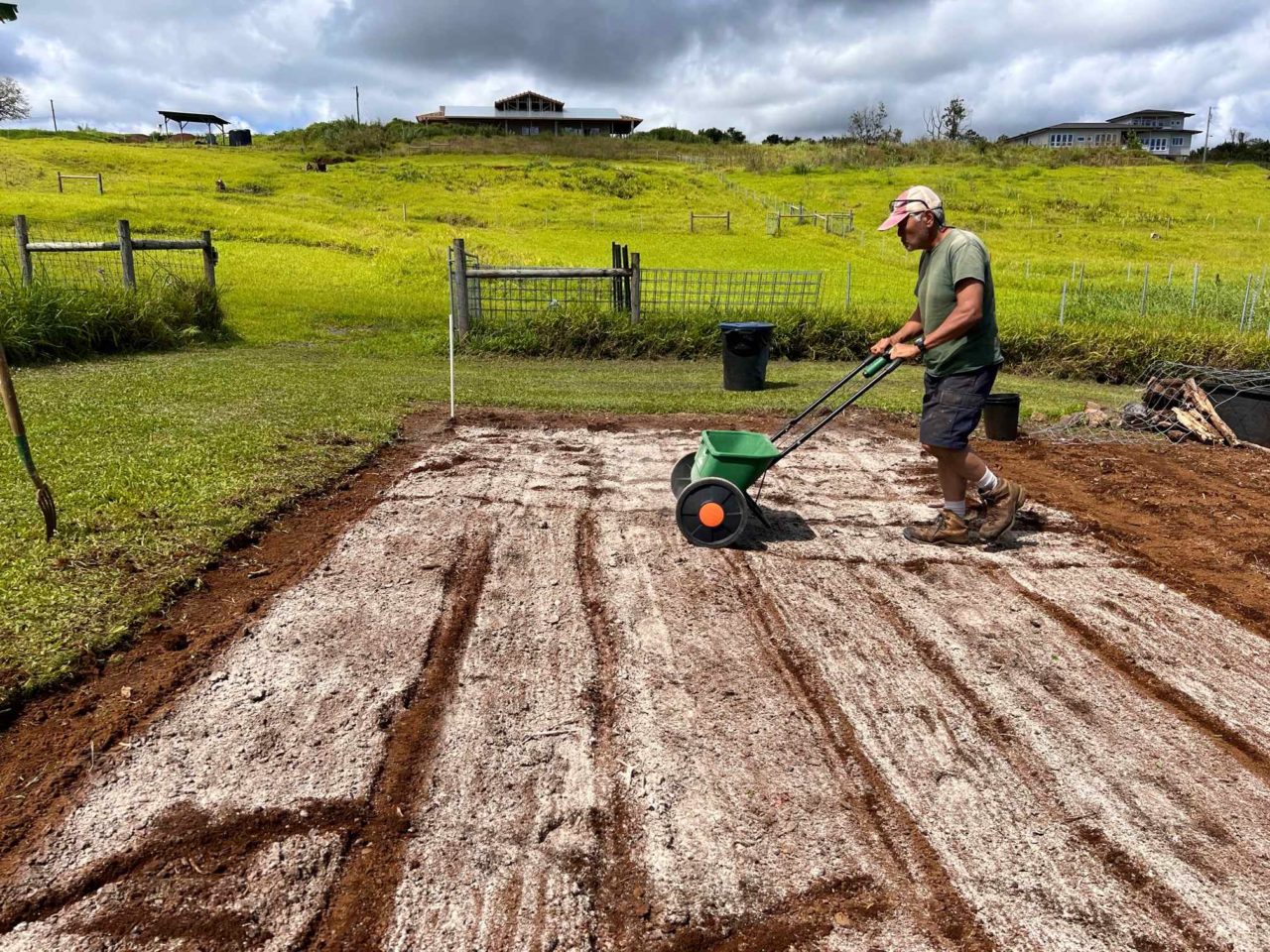
The Ohashi’s Soil Analyses–
The Nutrition Grown plot had a full array of nutrients and microbes applied according to Dr. Bogs’ interpretation of the soil analyses. The control bed had Bioflora, lime, bone meal, sulfate of potash, dolomite and boron added. Tim commented that, after seeing the results in the Nutrition Grown plot, more calcium was needed.
As seen on the soil analyses, the soil also needed phosphorus, iron, manganese, cobalt, molybdenum and silicon. We added dry humates to improve the exchange capacity—which definitely worked! We also did a mixed beneficial microbial application, as was done on all the other farms. Using more woody compost/mulch could have been helpful.
Yukie realized she had over-applied seawater to the Nutrition Grown plot (which we subsequently named the BOGS Heavy Salt beds), and so worked up another adjacent area to be the Nutrition Grown plot. This meant, unfortunately, that the Nutrition Grown plot (BOGS plot) was a couple of weeks behind the control and the BOGS Heavy Salt plots in getting amended. Therefore, there was less time for the soil to incorporate (“digest”) the nutrients. Fortunately, we still had great results with the trial.

Ohashi’s Microbiological Soil Analyses: (Post-trial comparison to the pre-trial report) Pre-trial bacterial level was 300/slide field on the initial check, and 25/slide field on the recheck. These are very low numbers. The soil microbiology was not resilient. Post-trial bacterial level increased to 700/slide field on the initial check, and was 100/slide field on the recheck. These represent a 133% increase and a 300% increase, respectively. A protozoan was seen post-trial. Protozoa are beneficial in that they eat bacteria, thus recycling the nutrients back to the soil.

Course and Farm Trial Evaluation comments by the Ohashis:
Evaluation: “What changes happened in your Nutrition Grown (amended according to the soil analyses) soil/plants versus the control?”
“Plant growth in the BOGS (Nutrition Grown) plot was more vigorous and bigger than the control plot.”
“The Beyond Organic (Nutrition Grown) method utilizes a detailed analysis of the existing soil nutrients and recommends natural amendments for an optimal growing environment. Dr. Jana Bogs’ knowledge of soil and plant nutrition is exemplary and her method proved itself worthy by the side-by-side trial at our farm. The evidence of superior plant growth in her Nutrition Grown method was clear.”
THE NEW FARM OF MATT DRAYER IN WOOD VALLEY
Matt, and his wife, Andrea, recently purchased a 25.5-acre farm which used to be a flower farm on which many chemicals were used. He is transitioning to more organic-type practices. Wood Valley is a very rainy area, therefore some minerals are in low supply due to leaching. Matt is growing a variety of vegetables and Mamaki tea, with plans for expansion, including putting in a variety of fruit trees. He sells primarily to food hubs, such as Adaptations, The Food Basket, and Hilo Products.
The Nutrition Grown plot had a full array of nutrients and microbes applied according to Dr. Bogs’ interpretation of the soil analyses. The control bed had NPK 16:16:16 (because it came with the farm) and calcium from Oahu added. Matt also applied Korean Natural Farming’s IMO (indigenous microorganisms) and comfrey fermented plant juice (FPJ) twice.
Picture: Matt (in center) with WWOOFers on amending day:

Matt Drayer’s Soil Analyses–
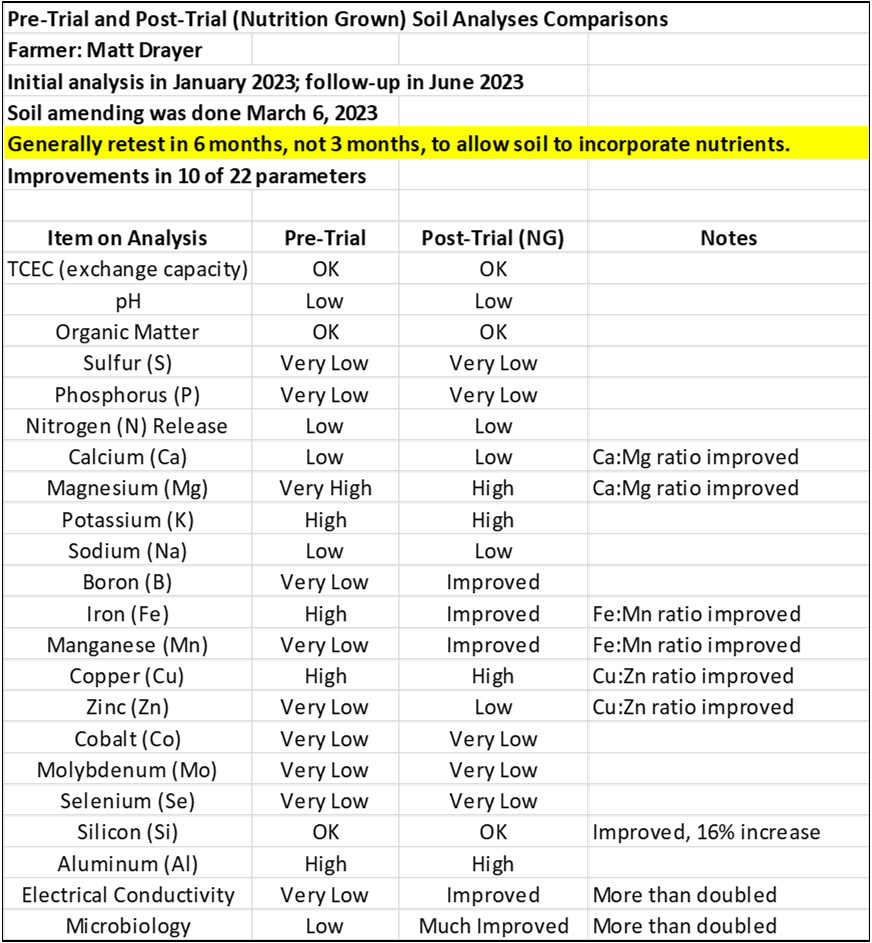
Matt’s Microbiological Soil Analyses– Post-trial comparison to the pre-trial report: The soil microbiology is much improved. Pre-trial bacterial level was 600/slide field on the initial check, and 30/slide field on the recheck. These are low numbers. The soil microbiology was not resilient. Post-trial bacterial level was much improved with increases to 1500/slide field on the initial check, and 1200/slide field on the recheck. These represent a 150% increase and a 3900% increase, respectively. Post-trial bacteria are now considered to be resilient.
Crop data and notes by Matt:
“All Nutrition Grown plants are superior in color, texture and growth size.”
“So basically, can you do my whole farm? This is amazing! My control plot is pathetic.”

Matt’s Nutrition Grown Little Gem lettuce at Harvest Time

Matt’s Control Plot Little Gem lettuce at Harvest Time.”
Course and FarmTrial Evaluation comments by Matt:
Evaluation: “What changes happened in your Nutrition Grown (amended according to the soil analyses) soil/plants versus the control?”
Matt: “Night and day difference in the Nutrition Grown lettuce. The control plot is a fraction of the size and less green.”
JASMINE LEITZEL & JUSTIN CANELAS==MANADINA FARM—NAALEHU
Jasmine and Justin have 7.8 acres which they have developed into Manadina Farm, LLC. They also have recently established Mauka to Makai—A Local Eatery, where they offer gourmet preparations of their own and other locally-sourced foods in a gorgeous mountain-to-ocean view setting. They grow a large variety of vegetables and fruits, some of which are sold via farmers’ markets, Adaptations food hub, and Ola Brew, or donated.
Jasmine and Justin decided to build raised beds for the trial because they want to have a lot of raised beds for their restaurant. The beds were made from local wood slabs. They were 4’ x 25’ each, and about 2’ deep. Jasmine explains, “Our Control bed AND (Nutrition Grown) Test bed were done hugelkultur style with 2 different types of soil and logs and sticks from macadamia trees and leaves and trunks of banana trees. Our Control bed also had dead fish carcasses buried on top of the sticks and leaves and under the soil.”
They ordered two different soils from local sources, mainly due to the cost of the soils. The cheaper one was used as filler at the bottom of the beds. It seemed to have a lot of cinder. The expensive manufactured “top soil” was layered 6” deep over that. Both soils were analyzed.
Jasmine goes on to further explain: “We added diluted seawater to the (control) bed on 3/14/23. Bed was planted on 4/3/23 with a mix of seed tray planted Little Gem lettuce and direct seeded Little Gem lettuce, direct seeded onions and direct seeded cilantro. We did not add mulch.
Our (Nutrition Grown) Test bed was amended on 3/13/23 (JB note: amended both the bottom and top layers according to the soil analyses, each tilled to 6” depth) and we added the microbial mix, alfalfa and diluted sea water on 3/14/23. The bed was planted on 4/3/23 with a mix of seed tray planted Little Gem lettuce and direct seeded Little Gem lettuce, direct seeded onions and direct seeded cilantro. We did not add mulch.”

Jasmine and Justin with walk-behind tiller turning amendments (a custom mix from the Nutrition Grown soil analyses) into the bed
Jasmine and Justin’s Soil Analyses–

Jasmine and Justin’s Microbiological Soil Analyses– Post-trial comparison to the pre-trial report: The soil microbiology is tremendously improved. Pre-trial bacterial level was 550/slide field on the initial check, and 150/slide field on the recheck. These are low numbers. The soil microbiology was not very resilient. Post-trial bacterial level was much improved with increases to 1500/slide field on the initial check, and 1500/slide field on the recheck. These represent a 173% increase and a 900% increase, respectively. The soil bacteria became extremely resilient. Unfortunately, the recommended woody compost/mulch did not get applied, which could have been helpful for building beneficial soil fungi.
Course and Farm Trial Evaluation comments by Jasmine:
Evaluation: “What changes happened in your Nutrition Grown (amended according to the soil analyses) soil/plants versus the control?”
Jasmine: “The (Nutrition Grown) gem lettuce grew bushier and darker green than the gem lettuce in the control bed. The Onions in the Beyond Organic (Nutrition Grown) bed grew much larger than the control bed. There were 4X more weeds in the control bed than the Beyond Organic (Nutrition Grown) bed.”
“As an amateur farmer and restaurateur, the Nutrition Grown program came at the perfect time for us to take advantage of being able to offer Nutrition Grown food in our farm-to-table restaurant. I learned a ton about the degradation of our soil health and nutrients in our food today and was beyond pleased to have an alternative method to increase the soil health and grow healthier food.”
Flavor and Nutritional Content Notes
As the farm crew stood around the beds tasting the lettuces, we all agreed that the Nutrition Grown was sweeter. The subsequent brix testing of the lettuce did bear this out to be true, showing a 24% increase in soluble solids, composed largely of sugars and minerals. Here is the composite plant tissue comparison showing the Nutrition Grown outpacing the control on most parameters:

THE FARM OF CHELSEA AND LORI COX—SOUTH POINT ROAD—WAIOHINU/NAALEHU
Chelsea and Lori recently purchased 17 acres and are now growing vegetables there for the first time. Fortunately, the land seems quite virgin and clean of chemicals. With the completion of the Nutrition Grown course, they are now happily selling a variety of produce at the local farmers’ market in Naalehu.

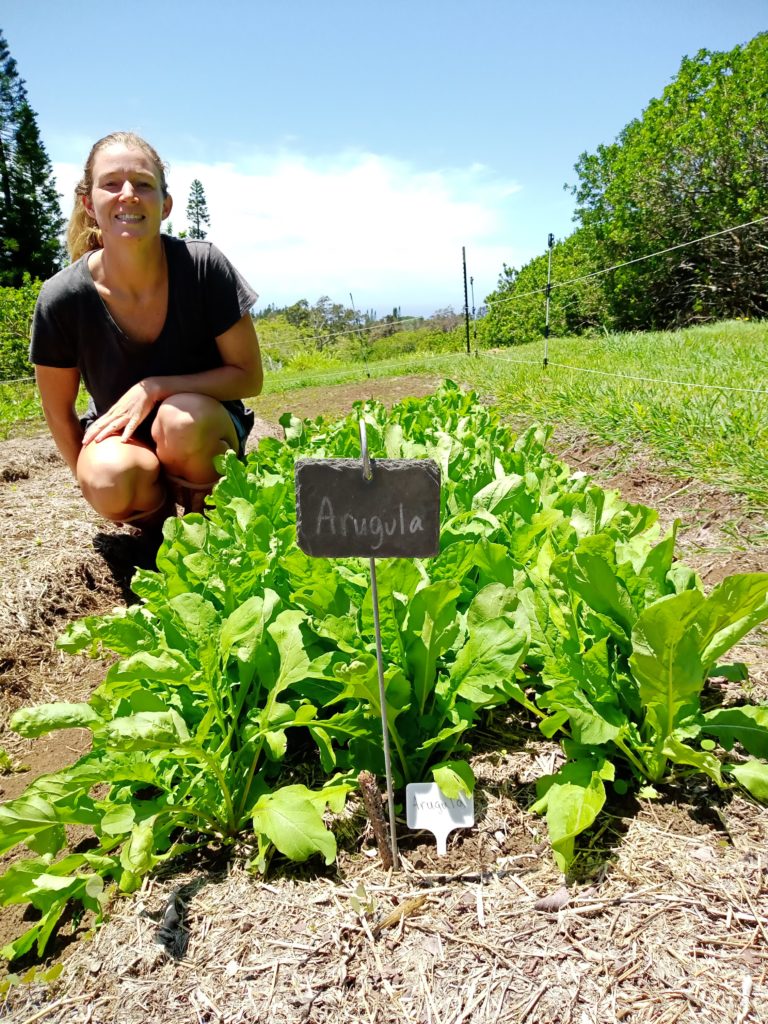
Chelsea by her Nutrition Grown bed of arugula
Chelsea and Lori’s Soil Analyses–

Chelsea’s Microbiological Soil Analyses– Post-trial comparison to the pre-trial report: The soil microbiology is much improved. Pre-trial bacterial level was 600/slide field on the initial check, and 30/slide field on the recheck. These are low numbers. The soil microbiology was not resilient. Post-trial bacterial level was much improved with increases to 1500/slide field on the initial check, and 1200/slide field on the recheck. These represent a 150% increase and a 3900% increase, respectively. Post-trial bacteria are now considered to be resilient.
Course and Farm Trial Evaluation comments by Chelsea and Lori:
Evaluation: “What changes happened in your Nutrition Grown (amended according to the soil analyses) soil/plants versus the control?”
Chelsea: “The BOGS (Nutrition Grown) plot had much more healthier, vibrant plants. Higher yields and less pest damage.”
“I am completely thankful for being a part of the Nutrition Grown soil program. Not knowing exactly what to do with my soil, but knowing I wanted to grow not only delicious food, but nutritionally-dense food for the community when the BOGS (Nutrition Grown) soil program was presented to me, I knew I had to do it. It was really neat and so beneficial to see the difference in food quality when we tend to our soil in the ways it needs. Again, I am very thankful for this opportunity and for the foundation it has given me in growing good quality veggies.”
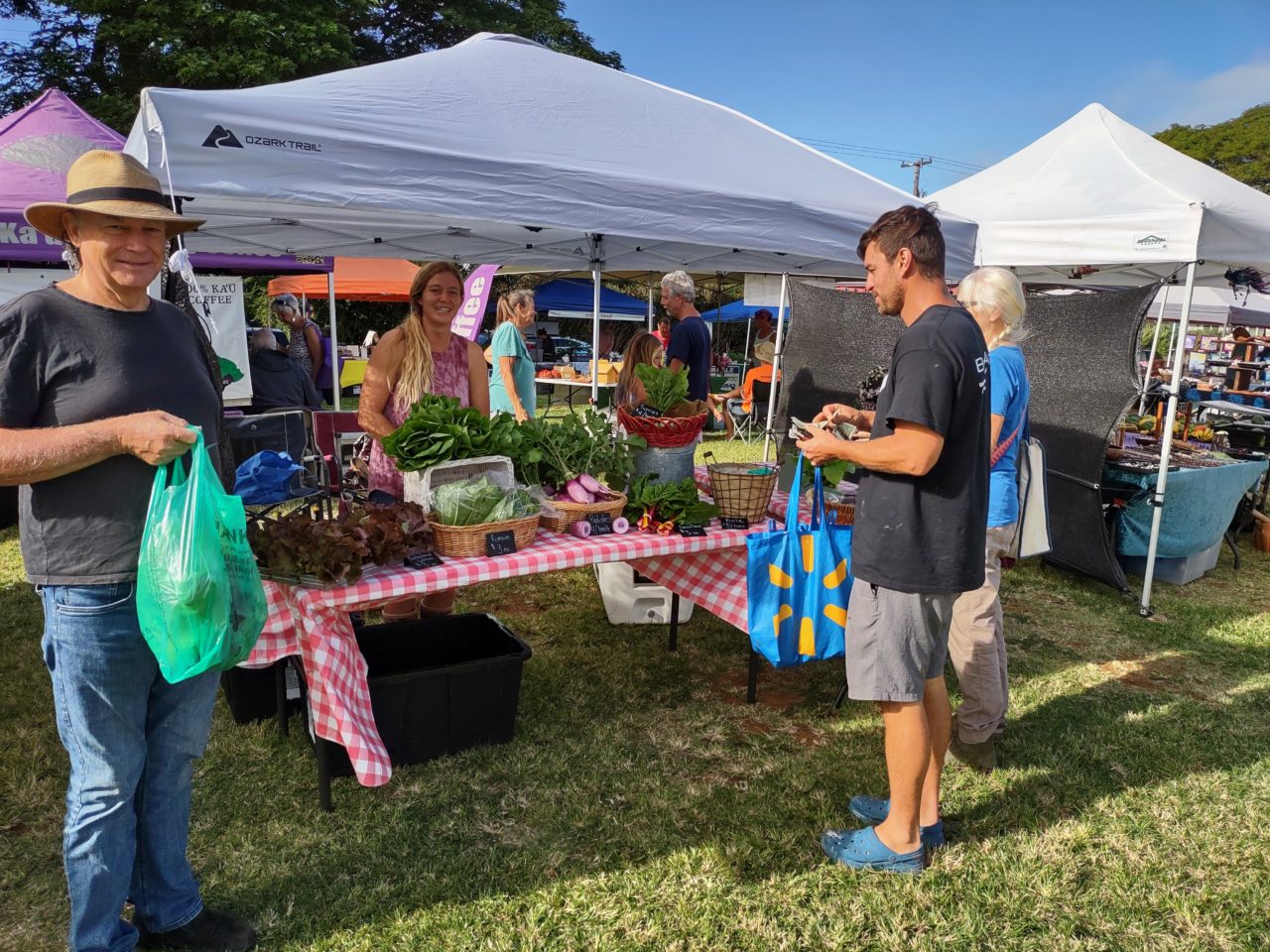
Photo: Here is Chelsea selling beautiful vegetables at her new farmers’ market booth in Naalehu. Lori (Chelsea’s mom) and Chelsea’s daughter can be seen in the background. Customers out in front of booth.
THE FARM OF WENDY AND ANDREW GRAVES—SOUTH KONA
Wendy has 5 acres in South Kona which she affectionately calls Lea`lani Farms. She is helped with her farm by her son and grandson. They are growing a variety of fruits and vegetables. With ramping up production, she has plans to sell at the local farmers’ markets, as well as donate fresh, live food to the Food Bank.
The Nutrition Grown plot had a custom-made array of nutrients and microbes applied. Unfortunately, the soil was too thin and rocky to be able to till amendments 6 inches down. Therefore, the amendments were added at a half rate of what was called for on the soil analyses with a drop spreader, and then raked into the surface. The control bed had cow manure, black cinders, and Sunshine microbial soil from Ace Hardware added.
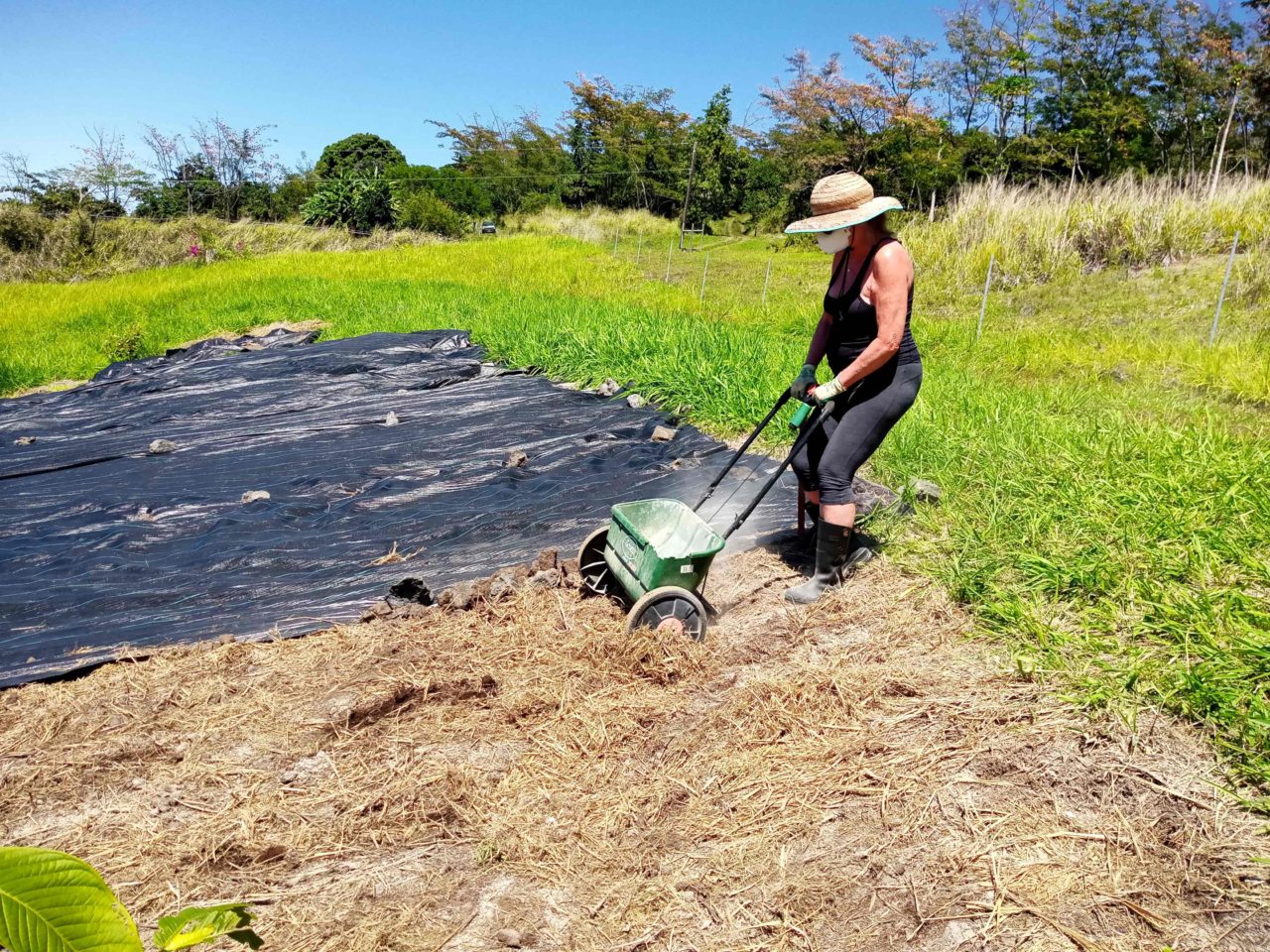
Here’s Wendy applying amendments (according to the Nutrition Grown soil analyses) with a drop spreader
Wendy’s Soil Analyses–

Wendy’s Microbiological Soil Analyses– Post-trial comparison to the pre-trial report: The soil microbiology is much improved. Pre-trial bacterial level was 600/slide field on the initial check, and 30/slide field on the recheck. These are low numbers. The soil microbiology was not resilient. Post-trial bacterial level was much improved with increases to 1500/slide field on the initial check, and 1200/slide field on the recheck. These represent a 150% increase and a 3900% increase, respectively. Post-trial bacteria are now considered to be resilient.

Control eggplant (Left) vs. Nutrition Grown eggplant (Right) They were consistently like this through the season. Which do you find more appealing?
Course and Farm Trial Evaluation comments by Wendy:
Evaluation: “What changes happened in your Nutrition Grown (amended according to the soil analyses) soil/plants versus the control?”
Wendy: “The amended soil produced larger, healthier, more pest resistant produce. That was a big difference. From now on I will be having soil analyses done and adding nutrients to balance the soil so plants/trees grow better.”

When examining the plant tissue data, it was noticed that the brix (soluble solids content) seemed to be related the length of time the plants were in contact with the Nutrition Grown soil. Lettuces which were direct-seeded into the soil had higher brix. The fewer days the plants had contact with the soil, the lower the brix, as seen in the following chart. Amazingly, there was a perfect correlation.

In the end, it’s all about producing better quality foods for human consumption. Even with the short periods of time the soils had to take up the nutrients between amending and planting, and the short periods of time the plants were in Nutrition Grown soil due to being started in trays and then being transplanted, we still saw significant nutrient increases overall in the Nutrition Grown lettuces compared with the control lettuces. The only two nutrients which showed a slight decrease from control to Nutrition Grown were phosphorus and sodium. These two nutrients are generally in sufficient to excessive amounts in human dietary intake levels.

Thanks to all the farmers and their crews who participated!

Recent Comments